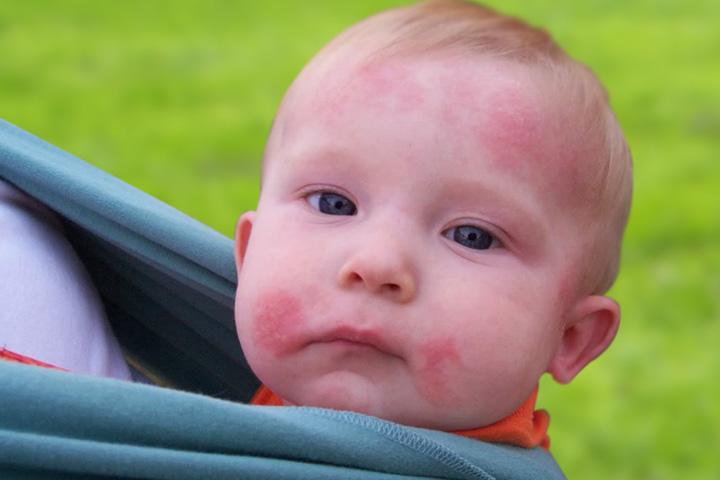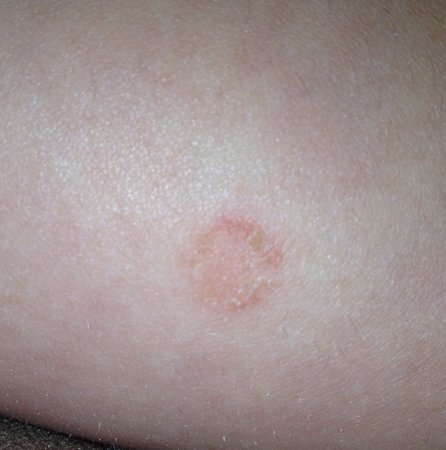Ringworm In Babies

Contents:
- What is Ringworm?
- Ringworm at Children: Contagious or Not
- The Causes of Disease
- Which Factors Contribute to the Development of the Disease in a Child's Body?
- Types of Ringworm
- Symptoms Ringworm in Babies
- Diagnosis and Treatment of Diseases
- Prevention of Disease
What is Ringworm?
Ringworm-it is a skin disease, which is easy to catch. Pathogenic fungus enters the body of a child through small scratches on the skin or micro traumas. In cases when a child immune function is weakened he gets into the group of risk.
Ringworm at Children: Contagious or Not
This skin disease is contagious. The incubation period may range from 5-7 days to 1.5-2 months. Not only the bald spots are contagious, but also skin flakes and hair fragments. The ringworm can be transmitted through direct contact to the infection carrier or spread by daily routine activities such as through clothes, personal hygiene items, toys. Newborn babies often become infected with ringworm by carriage if parents leave it in the stairwell of the house where infected animals wander.
It is worth to point out that ringworm pathogens are not affected by fresh air, show vitality and keep infecting the region for years. That's why it is necessary to treat the disease as soon as possible. However, it is necessary to confirm the diagnosis by a doctor. Caused skin formation will be examined under the Wood's fluorescent lamp, as well as scrapings will be taken from the affected areas of scalp.
The Causes of Disease
Symptoms of ringworm causes the activity of two fungal, both of them provoke the appearance of certain types of pathologies:
- microsporia;
- trichophytosis.
Which Factors Contribute to the Development of the Disease in a Child's Body?
Most significant are following factors:
- lack of vitamins in the child's organism;
- severe chronic pathologies;
- immune disfunction;
- presence of minor injuries on the skin.
Types of Ringworm

A disease such as ringworm at children can be divided into two main types based on which factor has triggered the infection:
- zoonotic;
- anthroponotic.
The first form is more widespread, the fungus gets into the body of a child during a contact with a sick animal. It is possible to get infected with trichophytosis from home cows, various rodents or horses. Mircosporia is a consequence of contacts with home or stray cats (dogs). Fungus infection often occurs while child is playing with animals, as well as through the fur, pet flakes of skin of the animal which contact epidermis of the child.
Anthroponotic form of ringworm is a consequence of contact of the child with already sick person. This kind of disease is not very common compared to previous one. The Mechanism of infection is sharing household items, personal hygiene items or direct interaction of the child with the person in the body which has intensified a fungus.
There is also one another typology of disease (based on the clinical picture of disease):
- infiltrative-suppurative form;
- chronic pathology;
- superficial ringworm.
Any of the types above vary by the duration of the hidden (incubation) period:
- on this way in case of superficial form of disease latent period lasts from five to seven days;
- infiltrative-suppurative type of disease is accompanied by a two-month hidden period of the disease
chronic phase of ringworm is characterized by alternating phases of exacerbation and remission, alternating over an extended period of time.
Symptoms Ringworm in Babies
How is ringworm manifesting at children? Mostly often, the symptoms of the disease occur at children's head (scalp), but sometimes the characteristic rash is affecting the smooth surface of the skin.
The appearance of a ringworm begins with scaly stains in white. The sizes of neoplasms may vary. If the symptoms of the disease appear on the scalp of the child, the hair lose its aesthetic quality – become lifeless and lose their usual radiance, break off to a length not more than 4 mm. This kind of clinical picture of a ringworm caused the name of the disease.
If the disease affects the smooth areas of skin of a child's body first of all there appear characteristic nodules which transform into oval or round white spots. Neoplasms are scaly. Rashes are accompanied by slight itching.
The systematic symptoms of children's ringworm are lymph nodes, general weakness, sometimes-hypothermia. If the disease has passed onto the chronic stage, after the disappearance of rashes deep scars may remain on the skin.
When should the parents take the child to a dermatologist? It must be done if your child exhibits such symptoms as:
- on the skin appear are one or more fuzzy red stains, which are oval;
- the child has dandruff;
- child's hair doesn't look healthy – it splits, breaks, lost its usual gloss;
- child itches all the time for no visible reason.
Diagnosis and Treatment of Diseases

The diagnosis of ringworm puts a dermatologist after an individual examination of the child. To identify the symptoms of the disease a special device is being used: the wood's lamp, which "highlights" affected fungus hotbeds of the epidermis.
Additional research methods are to study skin cells, hair follicles of the child items by the microscope, as well as seeding microscopic flakes of the epidermis. It has to be pointed out that correct and efficiently organized treatment of ringworm of a child at the right time invariably ends with a full recovery.
How to treat fungus disease? If the spot of appearance is only the scalp of the child's head, only local treatment can be applied. The types of treatment are different anti fungal ointments, creams and other mixtures.
Variants of traditional external treatment of the disease are:
- the affected skin should be treated directly after awakening with 2-5 % solution of iodine with alcohol;
- further affected skin areas should be treated by antimycotic ointment;
- not more than once per week following drugs should be taken: Zalain, Lamisil (in a pharmacy you can buy a cream or spray), ekzifin;
- within a month you should use clotrimazole, funginal (several times a day);
- ekzoderil ointment, lozeril – duration of therapeutic course is two weeks, at leas twice a day;
- it is possible to treat ringworm by tar, salicylic acid and sulfuric ointments. Use this items during a month, apply a thick layer to the skin just before to sleep.
It is recommended to cut the child's hair not less then once a week and after this to wash the affected areas with soap. If a child's symptoms are distributed throughout the body, local therapy should be combined with treatment with anti fungal systemic drugs. It is better to prefer the group of medicines of itraconazole and terbinafil.
They have a lot of significant advantages:
- drugs are easy to use;
- do not have toxic effects on the body of the child;
- show high performance results.
After drug therapy course is over, the child should be at least three months under the constant supervision of a dermatologist. Upon completion of the treatment the doctor inspects the child's body using wood's lamp: If no sign of the fungal infection was found, the child is considered as healthy.
Prevention of Disease
- It is necessary to avoid the contact to stray animals. It is not allowed to touch homeless animals, home animals should be instilled and regularly examined by a vet, especially in summer.
- If a child couldn't hold himself and touched a homeless animal, immediately wash his hands with soap.
- A person infected by ringworm should strictly follow the rules of personal hygiene. The persons who contacted him should periodically get examined to find out if there are any lesions on the skin.
Vidoe: Ringworm, When to Worry